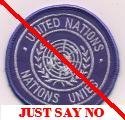A reality check ---the unthinkable---perhaps the inevitable....
Currently, there is mounting evidence that Saddam's government did provide significant intelligence and operational support for al-Qa'ida. The burning question remains, were any of Saddam's nuclear components, in whatever state of readiness, acquired by al-Qa'ida?
Unfortunately, there is no neat Cold War doctrine—no Mutually Assured Destruction—to stave off a nuclear attack from an asymmetric threat such as al-Qa'ida. The only counter-proliferation doctrine capable of keeping this enemy at bay is that of pre-emption—initiating first strikes on their turf to keep them off our own.["We love death. The U.S. loves life." —Osama bin Laden]
Al-Qa'ida's protagonist, Osama bin Laden, has called for an "American Hiroshima" in which al-Qa'ida cells detonate multiple nukes in U.S. urban centers. Al-Qa'ida has made it clear that they will use any means at hand to disrupt continuity of government and commerce in the U.S. in an effort to impede our influence in the Middle East. As Osama put it, "We love death. The U.S. loves life. That is the big difference between us." Osama's lieutenant Sulaiman Abu Ghaith says al-Qa'ida aspires "to kill 4 million Americans, including 1 million children."
Why does al-Qa'ida choose nuclear weapons? Because chemical weapons are low consequence, and biological weapons are indiscriminate—more likely to inflict mass casualties among Muslims in Asia and Africa than Christians in the West.
And what is al-Qa'ida's nuclear weapon of choice? While radiological dispersal devices (dirty bombs) are low tech, they are also, like chemical weapons, low consequence. The highest consequence nuclear weapon would be one utilizing U239, but plutonium is extremely hard to produce, unstable, easily detectable, and the bomb hardware is highly sophisticated, requiring great precision in the manufacture and machining of its parts.
A nuclear device utilizing U235 is therefore the weapon al-Qa'ida will use. Highly enriched uranium is more accessible and stable, and it requires a comparatively low-tech detonation sequence. This is precisely the type of weapon our sources indicate Saddam had in production.
Al-Qa'ida has a broad and amorphous network, including cells in North America. It is unlikely that these cells are in possession of a nuclear weapon, because moving such a device subjects both the mover and the weapon to detection—and our methods for detecting nuclear devices are very good.["We're living on borrowed time." —Dr. Graham Allison]
But they are not infallible. As Harvard's Graham Allison, author of "Nuclear Terrorism," grimly notes, "It's a great puzzle... I think that we should be very thankful that it hasn't happened already... We're living on borrowed time."
To be sure, an asymmetric nuclear threat is not the greatest potential hazard we face as a nation. That would be the very real threat of another Pandemic. Still, the nuclear threat remains very real—and it is greatly enhanced by the political infighting over OIF and domestic security issues such as the USA Patriot Act and our NSA terrorist surveillance programs.
From The Patriot



































0 Comments:
Post a Comment
<< Home